Exploring the Recycling of Plastic Easter Eggs


Intro
Plastic Easter eggs may seem harmless, brightening family celebrations and offering hours of fun, but they come with a set of environmental considerations. Often seen merely as festive decor, these colorful toys are largely produced from a type of plastic known as polyethylene, which presents unique challenges when it comes to recycling and disposal. As families engage in the time-honored tradition of Easter egg hunts, it’s essential to understand the potential long-term effects on the environment and how recycling practices can change the game.
In many households, the post-Easter routine involves tossing plastic eggs into the trash. However, little do most realize, many recycling facilities don’t accept these items due to the contaminants associated with the material or the lack of facilities equipped to process them adequately. This article seeks to clear the cobwebs surrounding this topic, shedding light on potential methods for recycling plastic Easter eggs, common misconceptions surrounding their disposable nature, and alternative approaches to ensure environmental sustainability while keeping the festive spirit alive.
Through this exploration, the article will also address the importance of awareness and mindful choices. From the materials used to create these eggs to their environmental impact, we'll cover it all to empower readers—be it families, teachers, or environmentally-conscious individuals—toward making informed decisions. Let's take a deeper look into what we can do about the plastic plight brought on by these seemingly innocuous holiday trinkets.
Understanding Plastic Easter Eggs
Plastic Easter eggs, simple in their design, carry more weight than one might assume when it comes to discussions of sustainability and environmental impact. They play a significant role in holiday traditions, particularly during Easter celebrations, where they are filled with goodies, hidden for hunts, and cherished by children. However, these eggs present a duality; while they serve as a source of joy, their recyclability is often overlooked. This article aims to illuminate the importance of understanding these fun yet problematic items.
Material Composition
The vast majority of plastic Easter eggs are made from polypropylene, denoted by the recycling code #5. Polypropylene is favored in the manufacturing of these eggs as it is both durable and lightweight. That durability is key—these eggs can withstand the rigors of play and the occasional drop without cracking or breaking. However, their resilience also presents a problem; polypropylene does not break down easily in the environment, which leads many to flick them away after their seasonal use.
Additionally, additives are often included to enhance color and texture, but these can complicate recycling efforts. Not every recycling facility is equipped to handle the specific types of plastics or the dyes used in the production of these eggs. Thus, it’s crucial for consumers to understand the material that makes up these seasonal delights to better navigate end-of-life options for disposal.
Common Uses and Popularity
Plastic Easter eggs have carved a niche in American culture, particularly within families that celebrate Easter traditions. They are not only used for egg hunts but also serve as containers for gifts, educational items, and even toys. These versatile eggs are highly popular due to their affordability and ability to hold a wide variety of treats such as chocolate, candies, or small toys.
But their appeal doesn’t stop at mere tradition—the colorful exterior of these eggs adds a festive touch to any celebration. It's not uncommon to find families purchasing large sets of these eggs, contributing to a significant market demand.
- Versatile Uses:
Filling these eggs with treats creates excitement and a sense of discovery in children during hunts. They are also recently being used in schools for educational purposes, helping teach children about counting or colors. - Popularity Boosted by Trends:
Social media has further propelled their popularity, with many parents sharing creative ways to use plastic Easter eggs during the holiday season.
Interestingly, however, this boom in popularity carries an underlying concern—it leads to a cycle of purchasing new eggs each year while older ones may get tossed in the trash. Thus, awareness about their disposal and recycling is essential for parents and guardians who want to raise eco-conscious children.
Recycling Basics
Recycling is crucial in the fight against environmental degradation. It serves as a bridge connecting consumption and sustainability. Understanding the foundational aspects of recycling can guide better practices when it comes to the disposal of everyday items, including the often-overlooked plastic Easter eggs. Knowing how recycling works empowers individuals and communities to contribute to a cleaner planet.
What is Recycling?
At its core, recycling involves collecting materials that would otherwise be discarded and transforming them into new products. This not only conserves natural resources but also significantly reduces the amount of waste ending up in landfills and the ocean. For example, recycling just one ton of plastic bottles can save enough energy to power a home for a year. Additionally, recycling helps cut down greenhouse gas emissions, playing a vital role in combating climate change.
Benefits of Recycling Include:
- Conservation of Resources: Reduces the need for raw materials, preserving forests, water, and other resources.
- Energy Savings: Manufacturing products from recycled materials usually consumes less energy compared to using virgin materials.
- Pollution Reduction: Less landfill waste means lower levels of air and water pollution associated with waste disposal.
Types of Recyclable Plastics
Not all plastics are created equally when it comes to recycling. Commonly accepted types in curbside recycling systems include:


- Polyethylene Terephthalate (PET): Found in bottles and containers. Often recycled into t-shirts, insulation, or carpets.
- High-Density Polyethylene (HDPE): Used in milk jugs and detergent bottles. Widely recycled into new bottles or piping.
- Polyvinyl Chloride (PVC): Used in pipes and medical equipment. Recycling options are limited, often downcycled into tiles and new products.
- Low-Density Polyethylene (LDPE): Typically used in shopping bags. Less commonly accepted, but some grocery stores recycle these.
- Polypropylene (PP): Found in yogurt containers and straws. Increasingly accepted in recycling programs.
Understanding Plastic Identification Codes
The recycling symbol, often seen on packaging, comes with a number inside a triangle of arrows. This is the plastic identification code that indicates the type of plastic and its recyclability:
- 1: PETE (Polyethylene Terephthalate)
- 2: HDPE (High-Density Polyethylene)
- 3: PVC (Polyvinyl Chloride)
- 4: LDPE (Low-Density Polyethylene)
- 5: PP (Polypropylene)
- 6: PS (Polystyrene)
- 7: Other (various other plastics)
Each code guides consumers on whether items can be recycled in their locality. However, it’s important to note that regulations can vary by region, so always check with local recycling programs.
"Understanding what can and cannot be recycled is the first step in waste management. If people don’t know how to recycle effectively, efforts can lead to contamination and increased landfills."
In summary, familiarizing oneself with the basics of recycling, the plastic types, and their identification codes is foundational. This knowledge serves as a useful tool in promoting better disposal practices for plastic items like Easter eggs, determining their future in the recycling stream.
Can Plastic Easter Eggs Be Recycled?
When considering the journey of plastic Easter eggs, we arrive at a crucial inquiry: can these colorful decorations find new life through recycling? The answer to this question matters not just for the Easter festivities but also within the broader context of environmental responsibility. Understanding the recycling potential of these items sheds light on how our choices can reverberate through ecosystems.
Recyclability of Polypropylene
Many plastic Easter eggs are composed of a material known as polypropylene (abbreviated as PP). This thermoplastic polymer is favored for its durability and flexibility, making it a common choice for Easter eggs. But what does this mean for recycling?
Polypropylene holds a recycling designation of number five within the plastic identification codes. While technically recyclable, the process isn't as straightforward as one might hope. To illustrate this point, consider the scenario where you place a used polypropylene container into the recycling bin. Not all recycling facilities are equipped to process PP efficiently. Sometimes, the cost associated with recycling this material outweighs the potential benefits, leading to low recycling rates.
As a result, you may find that your local recycling program doesn't accept plastic Easter eggs. Even if they did, these items require specialized processing. This complexity can create confusion for well-intentioned consumers aiming to contribute positively to their communities.
Local Recycling Capabilities
The recycling landscape varies significantly from one locality to another. In some regions, residents are provided with comprehensive programs that allow for various types of plastic, including polypropylene, while others only accept a narrow range. Before tossing those Easter eggs into the bin, it's wise to check the guidelines of your local waste management services.
Local recycling capabilities may be influenced by many factors. For instance, some cities prioritize sustainability efforts, investing in infrastructure that supports a more extensive range of materials. On the other hand, less-resourced areas might struggle to manage even traditional forms of plastic recycling. An excellent way for communities to understand their recycling options is through educational initiatives that highlight accepted materials.
Barriers to Recycling
Despite the potential recycling of plastic Easter eggs, significant obstacles remain. One challenge is public perception. Misunderstandings and misinformation regarding what can be recycled often lead to contamination of recycling streams. For instance, if someone accidentally includes Easter eggs in a collection for a different plastic, it could lead to entire batches being deemed unsuitable for processing.
Moreover, the consumer mindset plays a significant role. Certain sections of the population are not aware of the correct disposal methods or feel that their actions won't make a difference. These barriers can lead to a cycle where plastics end up in landfills instead of being repurposed.
To mitigate these issues, community efforts aimed at education and awareness dually serve to inform individuals and empower them to engage in responsible practices concerning plastic waste. As awareness grows, so can our collective action toward more sustainable disposal options.
"The success of recycling plastic Easter eggs hinges not only on the material itself but also on collective efforts to understand and address barriers in communities."
In summary, while the recycling viability for plastic Easter eggs poses certain challenges, the acknowledgment of polypropylene's properties, understanding local recycling capabilities, and tackling barriers set the stage for informed decisions that enhance sustainability efforts.
Environmental Considerations


Impact of Plastic Pollution
Plastic pollution has become an alarming topic across the globe. From sea turtles choking on plastic bags to birds mistaking small pieces for food, the consequences are dire. Plastic, unlike organic waste, does not decompose easily. A study published in Environmental Pollution states that plastic items can take up to 1,000 years to break down completely.
Moreover, microplastics, tiny fragments derived from larger plastics, invade waterways and ultimately enter our food chain. These pervasive particles have been found in various food items, including seafood and drinking water.
"Every piece of plastic that has ever been produced still exists in some form, a stark reminder of our consumption habits."
The significance of reducing plastic use or recycling it effectively cannot be overstated. Addressing this issue means tackling our plastic dependency head-on, pursuing alternative materials, and promoting practices for better waste management.
The Lifecycle of Plastic Waste
The lifecycle of plastic waste involves several stages: production, consumption, disposal, and potential recycling. Plastic Easter eggs, often made from polypropylene, enter this lifecycle when they are mass-produced and sold during festive seasons. After use, children often toss these eggs into bins or storage, forgetting their environmental footprint.
Once discarded, plastic goes through varied processes depending on local waste management systems. It might be buried in landfills, incinerated, or sent for recycling. However, not all plastic eggs can be recycled due to their small size and lack of demand in recycling markets, which leads to significant amounts ending up in landfills.
The flow of plastic in our society shows a need for a shift in how we view and manage plastic waste. We must aim for a circular economy where recycling isn’t an afterthought but part of the consumer's daily choices.
Sustainable Alternatives to Plastic Eggs
Finding sustainable alternatives can lead the way for future celebrations without damaging the environment. Firstly, consider using eggs made from biodegradable materials like bamboo or paper. These can break down much faster and have less of a carbon footprint.
Secondly, investing in reusable plastic eggs can decrease the need for single-use products. While they do still contain plastic, they offer a lifecycle that can stretch over many Easters, which is a more sustainable choice than buying new, non-recyclable plastic each year.
Lastly, involving children in eco-friendly activities for Easter can raise awareness about sustainability. Making DIY eggs from materials such as old fabric, cardboard, or even stones can not only be fun but also educational. By recognizing the impacts of plastic and creatively finding alternatives, families can celebrate holidays without compromising on environmental integrity.
Best Practices for Disposal
When it comes to managing plastic Easter eggs, adopting best practices for disposal is paramount. These practices aim to minimize environmental impact while promoting responsible behavior in disposing or repurposing these items. Following effective disposal methods can safeguard local ecosystems and bolster community efforts toward sustainability.
Proper Disposal Methods
Knowing how to properly dispose of plastic Easter eggs is essential in the fight against waste. Here are the key steps to consider:
- Check Local Guidelines: Each locality may have different rules regarding recycling. It’s crucial to familiarize yourself with your area's recycling programs. In many cases, plastic Easter eggs made from polypropylene are accepted, but you should verify this with your waste management authority.
- Clean Before Recycling: Before tossing them into the recycle bin, make sure these eggs are clean. Food residue can contaminate recyclables and cause entire loads to be discarded. A quick rinse is often enough.
- Separate from Regular Trash: If local recycling options don’t accept these eggs, seek alternatives to make sure they don’t end up in landfills. Looking for local drop-off locations that specialize in recycling plastics can be beneficial.
- Use Designated Recycling Bins: If your community provides specific bins for plastics, use them. Labeling these bins with the correct plastic identification code can help others understand what is acceptable.
"Every action counts; proper disposal is a step toward a cleaner planet."
Upcycling Ideas for Plastic Easter Eggs
With a touch of creativity, plastic Easter eggs can transform into something new and useful, rather than merely being tossed aside. Here are a few upcycling ideas:
- Garden Decor: Paint the eggs in bright colors and use them to decorate your garden. They can easily brighten up flower beds or add a cheerful vibe to your outdoor space.
- Storage Solutions: Use them to organize small items around the house, such as buttons, sewing supplies, or even as mini containers for kid's snacks. The options are endless!
- Craft Projects: Turn them into fun craft materials for kids. They can be transformed into various characters, critters, or used in school projects. This not only keeps the eggs in circulation but also sparks creativity among young minds.
- Educational Tools: Create a counting game or a color sorting exercise using the eggs. Parents and teachers can utilize them to make learning more interactive and engaging for children.
By implementing these disposal practices, alongside exploring upcycling routes, we can each play our part in reducing plastic waste and foster a culture of sustainability within our families and communities.


Community Action and Awareness
Raising awareness about the recycling of plastic Easter eggs is an essential component in fostering a culture of sustainability. Community action holds the untapped potential to transform how people perceive and manage waste. With the increasing awareness of the environmental consequences tied to plastic pollution, communities can come together to manifest genuine change. Emphasizing the collaborative aspect, it encourages everyone—families, schools, and local businesses—to engage in practices that support recycling initiatives.
Promoting Recycling in Local Communities
Promoting recycling within local communities can sometimes feel like herding cats; it takes a concerted effort to get everyone on board. However, it is crucial to underscore the significance of local recycling programs. When neighbors are informed about the best practices and available resources for recycling, they are more likely to participate actively.
- Establishing Recycling Events: Organizing community clean-up days or recycling drives can actively involve residents. Providing the right containers for plastic Easter eggs during these events can make a considerable difference.
- Information Campaigns: Utilizing local newspapers, social media groups, or community boards to spread information about recycling options can have a ripple effect. Sharing success stories from nearby families who have adopted sustainable practices can inspire others.
- Partnerships and Collaborations: Collaborating with local businesses can foster a sense of joint responsibility. Encouraging stores to give discounts or incentives to customers who bring back used plastic Easter eggs can boost recycling rates.
By leveraging these strategies, communities create an environment conducive to recycling, making it the norm rather than the exception.
Educational Initiatives for Families
Education plays a pivotal role in shaping a sustainable future. Families equipped with knowledge regarding recycling practices are empowered to implement these habits at home. Simple initiatives can make a world of difference.
- Workshops and Seminars: Local libraries or community centers can host educational workshops focusing on recycling, specifically tailored towards families. These can include fun activities like decorating used Easter eggs or other upcycling projects.
- Resource Distribution: Providing brochures or digital resources detailing how to recycle effectively enhances understanding. Information about what can and cannot be recycled is crucial.
- Incorporating Recycling in Family Activities: Making recycling a part of family playtime encourages children to take part. Gardening with recycled materials or art projects using plastic eggs can be entertaining yet educational.
Engaging Children in Sustainability Practices
Motivating children to embrace sustainability is perhaps one of the most rewarding investments for the future. Engaging them early ensures that the new generation carries forward the principles of recycling and environmental awareness.
- Hands-On Activities: Activities like creating scavenger hunts that include finding recyclable materials can be both fun and educational. It instills an innate curiosity about waste and its lifecycle.
- Educational Games and Crafts: Craft sessions that require using plastic eggs teach recycling’s value in a playful format. Explaining how these activities can help the planet makes them more meaningful.
- Storytime Sessions: Integrating stories that highlight the importance of recycling can capture children's attention. Books that narrate the journey of recyclables can create a lasting impression.
"The next generation will not only witness the impact of our actions today but will hold us accountable for what we leave behind."
By implementing these strategies, not only do communities nurture environmentally conscious individuals, but they also weave the fabric of a society where recycling becomes a fundamental value shared across generations. Encouraging collaboration, education, and engaging practices can revive the local commitment towards recycling, especially concerning plastic Easter eggs.
End
The topic of recycling plastic Easter eggs bears significant weight in today's society, particularly as we grapple with the consequences of plastic pollution. Understanding the journey of these colorful collectibles from celebration staples to potential waste is vital for cultivating sustainable practices. This article sheds light on the recyclability of plastic Easter eggs and the broader context of plastic waste management.
The Future of Plastic Easter Eggs
Looking ahead, the future of plastic Easter eggs hinges on innovation and a shift in consumer behavior. Manufacturers are exploring biodegradable materials to replace traditional plastics. Companies like Eco-Products are pioneering plant-based alternatives that could possibly phase out traditional plastic eggs altogether. Such changes would not only reduce reliance on petroleum-based products but also lessen the environmental impact associated with plastic waste.
Potentiality also lies in the concept of durability and reusability. Encouraging families to use the same plastic egg year after year can truly elevate their value, turning them into lasting holiday mementos rather than single-use items. This can help in lowering the production of new plastics and making the most of existing ones.
From an educational standpoint, instilling practices around recycling and proper disposal in younger generations is equally important. Classrooms that engage children in discussions about recycling and the lifecycle of plastics can prepare them to embrace responsible habits, ultimately leading to a decrease in plastic waste.
Call to Action for Sustainable Practice
As consumers, we hold the power to influence both the market and environmental policies. We can actively seek out brands for that are comitted to sustainable production methods when buying plastic Easter eggs or any plastic items. Lobbying for better recycling options in local communities is key too. Communities could benefit from education programs that detail how to recycle effectively, highlighting local resources.
Here are small steps everyone can take to begin making a difference:
- Choose Sustainable Products: Opt for eggs made from biodegradable materials or go for fabric-branded ones like those from Fable Path.
- Participate in Local Clean-Ups: Join community clean-up efforts focused on reducing plastic pollution in parks and local play areas.
- Stay Informed: Keep an eye on local recycling rules to maximize the chances of plastics being processed correctly.
"Small changes, when combined together, yield significant difference in addressing plastic waste."
In summary, while the concern over plastic consumption grows louder, the in-depth knowledge gained about plastic Easter eggs might open doors for innovative changes. As we collectively push toward more sustainable practices, the pathway ahead transforms flickering uncertainty into a more optimistic vista for future generations.



